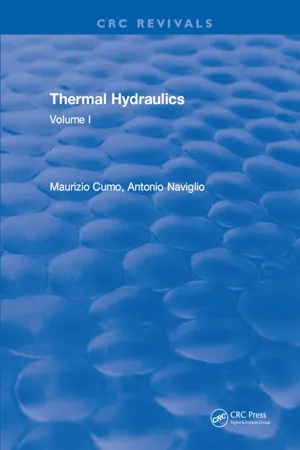Technology & Engineering
Flow Regime
Flow regime refers to the characteristic behavior of fluid flow within a system, often categorized based on factors such as velocity, density, and viscosity. It helps engineers and technologists understand and predict how fluids will behave under different conditions, enabling the design and optimization of systems such as pipelines, channels, and heat exchangers.
Written by Perlego with AI-assistance
Related key terms
2 Key excerpts on "Flow Regime"
- eBook - ePub
Thermal Hydraulics
Volume I
- Maurizio Cumo(Author)
- 2018(Publication Date)
- CRC Press(Publisher)
Chapter 3 Flow RegimeS I. INTRODUCTIONIn two-phase flow fluidodynamic and thermal problems, the knowledge of the phase distribution inside the containment (channel, pipe, HX equipment) is of primary importance. Several typical flow situations have been identified (Flow Regimes), where different interactions between the two phases and between each phase and the containment wall may be recognized; this leads to different overall behaviors of the two-phase mixture. The most relevant parameters affected by the nature of the flow pattern (distribution of the phases in the flow or Flow Regime) are pressure drops and heat transfer coefficients (friction between fluid and wall varies greatly with the nature of the phase in contact with the wall; heat transfer greatly depends on the nature of the phase in contact with the wall, its velocity, etc.).In this chapter, Flow Regimes typical of the most common applications are considered, together with methods for the evaluation of the void fraction in two-phase systems and of the conditions for flooding. These last two aspects are included owing to the characteristics of the evaluation methods presently used, based on phase-interaction analyses, in connection with the Flow Regime determination methods (Section II.A).II. Flow RegimeSThe importance of predicting the actual Flow Regime both in a piping system and in a heat exchange apparatus comes from the necessity of limiting the uncertainties at a design stage, especially as far as stability aspects or the possibility of unsafe operation conditions are concerned. Such aspects are connected to the relevant pressure drop variations that may follow a variation of Flow Regime (Chapter 4 ). In some cases, as in natural circulation systems design, the functionality of the system itself depends on the specific Flow Regime (in a natural circulation system, for instance, a separation of the two phases must be absolutely avoided).A. Analytical Methods and Influence Parameters - eBook - ePub
Petroleum Engineering Explained
Basic Concepts for Novices
- David Shallcross(Author)
- 2020(Publication Date)
- Royal Society of Chemistry(Publisher)
The volumetric flow rate is 0.173 L s−1 or 0.000173 m3 s−1 .For a pipe of circular cross section,A diameter of 5.08 cm is equal to 0.0508 m.7.8So,Thus,Substituting these values into eqn (7.6) we find,As this value is well above 4000, the water is passing through the pipe in turbulent flow.7.2.2 Multiphase Flow
Multiphase flow occurs when two or more separate and distinct phases flow within a pipe. Two-phase flow might involve the flow of oil and natural gas, water and natural gas or oil and water. Three-phase flow might involve the flow of oil, water and natural gas all together in one stream. Multiphase flow can be very complex even in simple pipe geometries. The flow patterns encountered in a pipe will depend upon the fraction of the pipe volume occupied by the different phases, as well as whether the pipes are horizontal or vertical.Seven different Flow Regimes involving the flow of a liquid and a gas in horizontal pipes are presented in Figure 7.3 . The sequence of Flow Regimes shown range from bubble flow, when the fraction of gas in the pipe is relatively low, to spray flow when it is the fraction of liquid that is low. Let's consider these regimes in turn now.- Bubble flow – fraction of gas in the gas/liquid mixture is relatively low. The gas travels as bubbles at the same speed through the pipe as the liquid. The bubbles are essentially just carried along with the flowing liquid. At lower liquid velocities, the bubbles will have a tendency to ride along the top of the pipe.
- Plug flow – as the fraction of gas in the mixture increases the gas bubbles coalesce into large plugs. These continue to be carried along the top of the pipe, but an observer at the top of the pipe would see them as alternating slugs of liquid and gas.
- Stratified flow
Learn about this page
Index pages curate the most relevant extracts from our library of academic textbooks. They’ve been created using an in-house natural language model (NLM), each adding context and meaning to key research topics.

